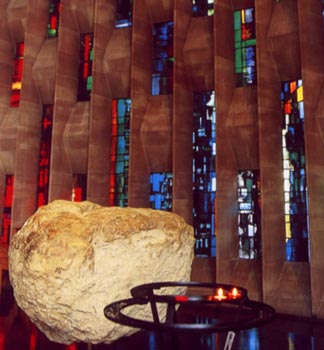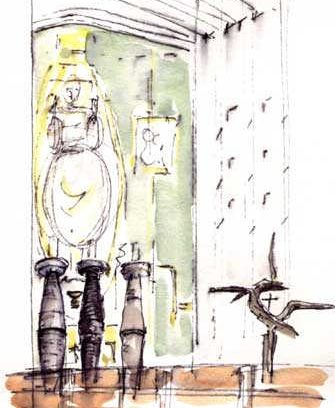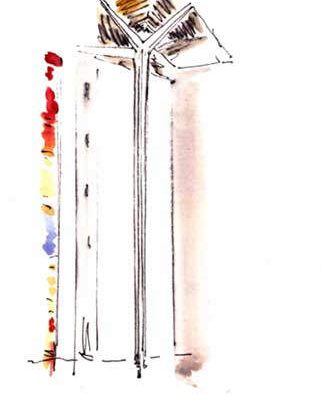This website uses cookies
This website uses cookies to enable it to function properly and to analyse how the website is used. Please click 'Close' to accept and continue using the website.






June 2002 - Coventry Cathedral
The 40th anniversary of the consecration of the new Coventry cathedral was celebrated in May 2002. A twentieth century building and a ruin of medieval fabric combine to form the cathedral as it functions today.
The history of Coventry Cathedral starts in 1043 but the most dramatically recorded (and for some people still remembered) event was the destruction in 1940 of the Cathedral alongwith much of the city around it, by Luftwaffe bombers. The subsequent activity is inspirational; from the creation of a cross from charred timbers and another of medieval nails on the morning after destruction, to the collaboration between a city, the architect and artists.
It is the outcome of those collaborations: The tapestry, the metalwork and the glass all within the setting of twentieth century architecture that continue to inspire visitors today.
In plan the new Cathedral is at right angles to the old. They share the same rose-red sandstone exterior, but where one is worn, battered and fallen from bombing and time, the other stands in sheer upright strength. Both provide a dramatic setting for the art commissions of building elements, fittings and finishes
Sir Basil Spence was architect of the Cathedral. He was also the co-ordinator of the whole operation of commissioning artists and craftsmen with the skills to create a variety of elements, including glass, congenially juxtaposed and working together as a whole. This alchemy of art and architecture is the focus for presenting the Cathedral as ‘building of the month’.
Sir Basil Spence believed that the architect, as leader of the team, should collaborate at the earliest possible stage with his engineers and artists. With the art in progress there was also a reduced risk of it being lost in any subsequent budget cut. He was therefore careful to commission work from the outset. Artists were sought to suit each project and the artist’s freedom was maintained.
A clear glass screen engraved by John Hutton enables a visual connection to be made between the two buildings. At the monumental porch to the new building Jacob Epstein’s cast bronze of dominates the steps from the road.
Inside the new cathedral the Gothic proportions of slender tall columns set a dramatic frame for decorative detail. The simple lines of the hammered concrete high altar are set at the base of the structured design of the tapestry, , designed by Graham Sutherland.
One of the most memorable impressions from visiting the Cathedral is the impact of colour and light created through the windows. John Piper was commissioned for the Baptistry windows , to complement the tapestry. Piper worked with Patrick Reyntiens, master designer and maker of stained glass, to translate his ideas.
John Pipers interest in glass derived from research into colour at the beginning of his artistic career, trying to find out how the restricted use of rich colour in medieval stained glass provided a positive response in him whereas free use of colour in paintings did not. The burst of light in the Baptistry represents the Burgeoning of the Light of Creation or the Holy Spirit on the World.
The nave windows are the work of Geoffrey Clarke and Keith New, discovered at the Royal College of Art, with Lawrence Lee their teacher. Their skills combined to produce the modern windows with bright rich colours and strong design that Spence wanted. The Chapel of Unity glass is by Margaret Traherne whose thick abstract glass set in concrete impressed Spence.
There are many other inspired works. These include the lectern and pulpit designed in Spence’s office by Anthony Blee with the bronze eagle by Dame Elisabeth Frink and also tablets on the walls with lettering by Ralph Beyer.
In 1962 response to the new building was mixed. For some it was too progressive while for many others the ideas of the 1950s had become outdated because of liturgical changes. It has however survived and appears as contemporary now as then.
The Millennium Chapel is a recent reuse of space defined by a glass screen etched by Jane McDonald. This continues the precedent set by Spence for art creating architectural scale elements.
Legislation, regulations and best practice standards in design for the built environment have developed since completion of the Cathedral in 1962. This includes a greater concern for accessibility, therefore some approaches to and areas within the building may now be considered a challenge for visitors, such as steps only at some level changes. However, during a visit in May 2002 the building appeared to be responding well to all the demands imposed by people using it. The care in commissioning art as part of the architectural concept is still evident in the experience of visiting the cathedral today.
Look for past Buildings of the Month by entering the name of an individual building or architect or browsing the drop down list.

Become a C20 member today and help save our modern design heritage.